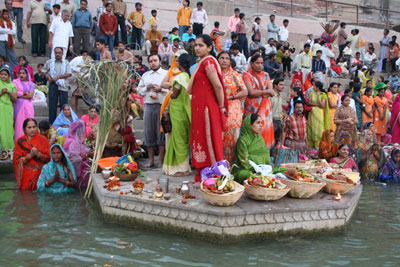What to expect on India tour
India offers an exotic kaleidoscope of sights, sounds and smells. The contrasts are amazing. People still use water from public wells to wash their storefronts and trucks, as cows pick through garbage along the curb. Women wear bright, colorful saris while going about their daily activities.
My husband, Ray, and I experienced this during the “Heart of India” tour with Overseas Adventure Travel, or OAT (Cambridge, MA; 800/493-6824, www.oattravel.com), Oct. 22-Nov. 7, 2008. (In 2010, the tour price, land only, is $3,095 per person.)
Our itinerary focused on Delhi, Jaipur, Agra, Khajuraho and Varanasi, with a featured excursion “into the heart of rural India,” where we visited Ranthambore National Park and an OAT camp. Excluding the two nights and related long drives during this excursion, we found the trip to be good.
On the two game drives in Ranthambore, we used 20-passenger, topless vehicles without suspension systems, resulting in bone-jarring experiences and limited visibility. For our stay there, while the veneer of the Nahargarh Hotel proved impressive, our spacious room smelled badly of mold. Also, due to “problems” with the local village, we were restricted to the camp compound; hence, the promised opportunity to “mingle with the locals and gain an understanding of rural life” was not an option.
Our guide, Ajay Paliwal, was superb. He frequently stopped the bus so we could watch farmers in the fields, visit homes along the road or shop for vegetables in a local market.
While in Jaipur, we enjoyed Diwali, a Hindu festival celebrated similarly to our Christmas and New Year’s combined. We saw brightly decorated homes and streets, tasted holiday candies, observed private worship and lit sparklers and fireworks. In Varanasi we witnessed processions of women making offerings to the god of the sun during the Chhath Festival. These were trip highlights.
Now for practical specifics.
India has outsourced its visa processing to the online Travisa Visa Service (https://indiavisa.travisaoutsourcing.com), which proved both efficient and easy to use. I would not waste my money using the service suggested by OAT.
A wealth of maps and travel guides is available upon request to the Government of India Tourist Office (1270 Avenue of the Americas, Ste. 1808, New York, NY 10020; www.incredibleindia.org).
Per OAT, the CDC recommends that travelers to India take antimalarial medication; we took malarone with no negative side effects. The “DK Eyewitness Travel Guide: India” also suggests that visitors get vaccinated against tetanus, typhoid and hepatitis A and B. I also take Pepto-Bismol, Imodium and Sudafed in my medical kit, and I carry lots of Purell or Handi Wipes®. The air pollution, especially in Delhi and Agra, is severe.
In India, baksheesh, or tipping, is a way of life; everyone expects to receive a gratuity. Always carry 10-rupee notes (about 20¢) for toilet attendants (one note) and others. I found hotel cashiers quite sympathetic when I asked if they could exchange a 100-rupee note for ten 10s so I could use the toilet.
We saw only one ATM during our trip. Cash is necessary.
When making purchases, negotiate for 70%-80% of the asking price. Don’t bargain where the price is listed as a “fixed price.”
OAT’s pretrip materials described the 25- to 39-seat, air-conditioned bus that would be used. They cautioned, “Buses in India are locally assembled, smaller, and not of the same standard as those used in Europe or elsewhere. The roads are often dusty and very bumpy. Some travelers find an inflatable seat cushion to be valuable on the longer drives.” Take this caution seriously!
OAT also cautioned that this adventure is most suitable for those who “live an active lifestyle, enjoy good health and mobility, are comfortable participating in three to five hours of daily physical activities, and are able to walk three miles unassisted.”
Do carry temple socks and an elbow-length sleeved shirt with you for the Jama Masjid mosque in Delhi and other mosques that you might visit.
Security at the Taj Mahal was very strict. Bags, pens, paper and most other items were not permitted beyond security. Only cameras, water and essential medications were permitted. Sunrise is better than sunset, and lines were long already at 6:30 a.m.
Do carry a flashlight for the evening and early-morning visits to the Ganges in Varanasi.
Quoting the OAT brochure, “Traveling in India can be very challenging, both mentally and physically. The dust, pollution and large crowds in cities; the poverty, and the persistent beggars can be distressing for some travelers. For the adventurous soul, however, these very challenges — in addition to the country’s beauty, spirituality and diversity — make India a uniquely rewarding destination.”
If you opt to visit India, expect grueling travel days and challenges, keep an open mind, and carefully select your travel itinerary.
WANDA BAHDE
Summerfield, FL

